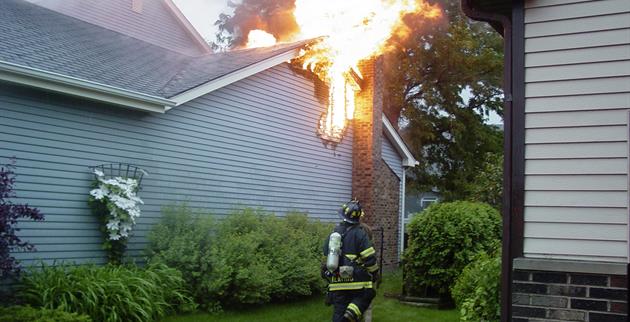

Chimney fires happen more often than you think, and have likely been self-contained before you knew otherwise.
Chimney Safety
Your chimney—and the flue that lines it—adds architectural interest to your home, but the real function is to carry dangerous flue gases from your fireplace, wood stove or furnace safely out of your home. As the weather gets cooler and you relax in front of your fireplace, know the facts about chimney fires!
Basking in the warmth of your fireplace or wood stove might be a fall and winter pastime for you and your family, and the last thing you are likely thinking about is the condition of your chimney. However, if you don’t give thought to it before you light those cold weather fires, your enjoyment may be short-lived.
Why?
Dirty chimneys increase you’re the risk of chimney fires, and if residue and debris catch on fire, it can cause damage to the structure of your home, even destroy your home and severely injure or kill people.
Chimney fires have been described as creating:
- Loud cracking and popping noises
- A lot of dense smoke, and
- An intense, hot smell
Chimney fires can burn at an explosive and rapid pace!
Undetected Chimney Fires
A fire belongs in the fireplace, so it is easy to assume that the noises, smoke and smells are all part of the experience, but slow-burning chimney fires often go undetected until it is too late. Chimney fires happen more often than you think, and have likely been self-contained before you knew otherwise.
What You Must Know
Fireplaces and wood stoves are designed to safely contain wood-fuel fires, while providing heat for your home. The chemistry that occurs during this process, like the substances produced when wood burns (smoke, water vapor, gases, unburned wood particles, hydrocarbon, tar fog and other minerals), can build up over time, creating a residue that sticks to the inner walls of your chimney called creosote.
Creosote is a black or brown residue that can be crusty and flaky; almost tar-like, drippy and sticky. Sometimes it can be shiny and hardened. No matter its condition, all forms are highly combustible, and if it builds up in sufficient quantities, and the temperature reaches high enough, it can combust.
Get Your Chimney Inspected By a Professional
The Chimney Safety Institute of America (CSIA) certifies chimney sweeps and recommends that if you’re shopping for an inspector, make sure they have the CSIA approved credentials! To find a certified professional near you, start your search here!
During National Chimney Safety Week, Preferred Mutual reminds you to perform proper maintenance on your chimney each year before the cold season begins to help protect your home, your loved ones and your belongings.
It’s also a perfect time to call your independent agent and make sure you have the best coverage for your home and your wallet! When you’re covered by Preferred Mutual, you’re living assured.